ВУЗ: Казахская Национальная Академия Искусств им. Т. Жургенова
Категория: Книга
Дисциплина: Не указана
Добавлен: 03.02.2019
Просмотров: 17278
Скачиваний: 51
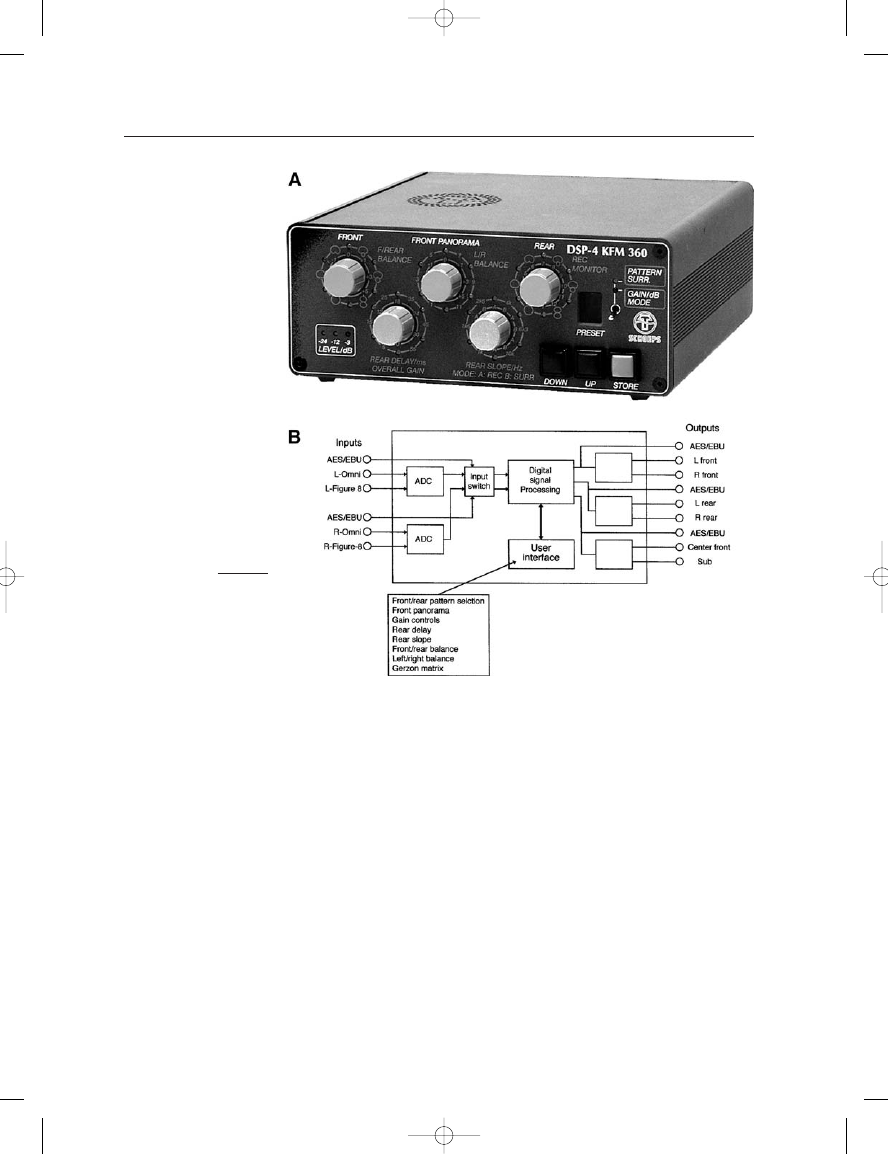
SPACED ARRAYS
The surround ambience microphone (SAM) array
An arrangement of four cardioids at 90
has been proposed by Theile of
the German IRT (Institut für Rundfunktechnik). As shown in
Figure 15–12, these microphones are located at the corners of a square
measuring 21 to 25 cm per side (8–10 in). The array is known as SAM
(surround ambience microphone). The spacing of the elements of the
array adds significant time cues to supplement the amplitude cues delin-
eated by the microphone patterns. The array is generally intended to pick
up ambience in live spaces in conjunction with traditional accent micro-
phones center channel pickup (Theile, 1996).
The sound performance lab (SPL) array
Figure 15–13A shows a photo of the German SPL array of five multi-
pattern microphones. The array offers a high degree of flexibility, with
15: Surround Sound Microphone Technology
253
FIGURE 15–11
DSP-4 control unit for
Schoeps KFM 360; photo
of unit (A); signal flow
diagram for control unit
(B). (Data courtesy of
Schoeps.)
Earg_15.qxd 14/9/04 2:56 PM Page 253
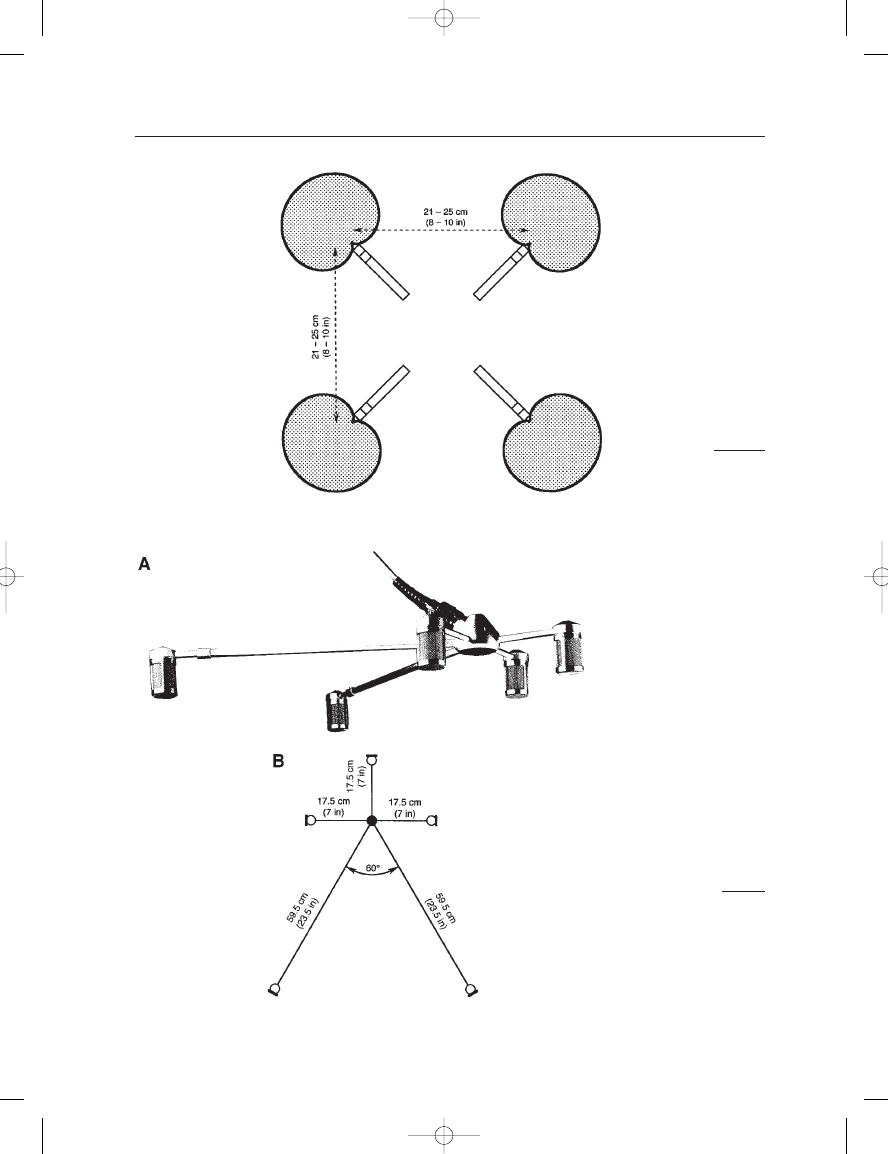
THE MICROPHONE BOOK
254
FIGURE 15–12
Details of the SAM
cardioid microphone array.
FIGURE 15–13
Details of the SPL
microphone array: photo
of array (A); plan view of
array showing normal
dimensions (B). (Photo
courtesy of SPL, USA.)
Earg_15.qxd 14/9/04 2:56 PM Page 254
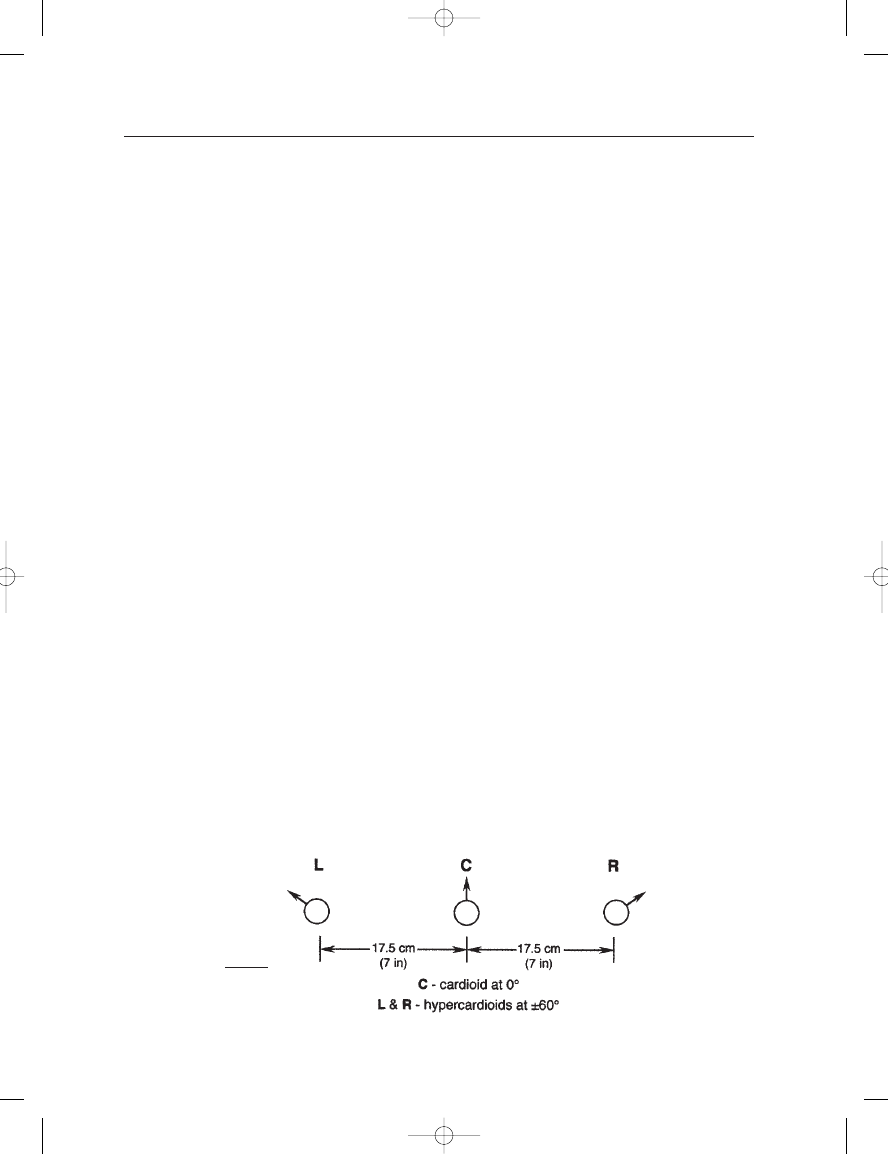
individual setting of distances between microphones (using telescoping
sections) and horizontal aiming directions for each microphone. The ori-
entation shown at B represents normal operating distances among the
five microphones. An array such as this may be used to produce a basic
spatial “signature” of a recording environment. Accent microphones
may be used as needed with the basic array. The control unit provides a
number of functions, including microphone pattern switching, ganged
level control, sub-bass output control, and various panning functions.
Note that the SPL array bears a striking resemblance to the Decca tree,
as discussed in Chapter 13.
FRONTAL ARRAYS
In this section we will describe methods of specifically picking up the
three frontal signals for optimum effect and separation. These arrays
may be used with a variety of pickup methods for general room ambi-
ence. One of the problems with three-microphone frontal arrays with
each microphone fed to its own frontal loudspeaker is the reproduction
of three phantom images produced by the microphones taken two at a
time: L-C, C-R and L-C. If there is considerable pattern overlap of the
three microphones, the phantom images between the outside pair will
conflict with the real image produced by the center loudspeaker. This can
be minimized by using hypercardioid or supercardioid patterns for the
left and right microphones, which will minimize this tendency
Klepko (1997) describes the microphone array shown in
Figure 15–14. Here, the left and right microphones are hypercardioids,
and the center microphone is a standard cardioid. The use of hypercar-
dioids for left and right pickup will minimize the strength of any phan-
tom image between the left and right loudspeakers in the playback
array.
Schoeps proposes the frontal array shown in Figure 15–15. Known
as OCT (Optimum Cardioid Triangle), the array uses increased spacing
and supercardioids facing full left and full right to minimize phantom
images between outside loudspeakers. The center cardioid element is
positioned slightly forward of the two supercardioids to give the center
channel signal a slight anticipatory time advantage for frontal pickup,
relative to the left and right microphones. The added omni microphones
15: Surround Sound Microphone Technology
255
FIGURE 15–14
Three-microphone frontal
array proposed by Klepko.
Earg_15.qxd 14/9/04 2:56 PM Page 255
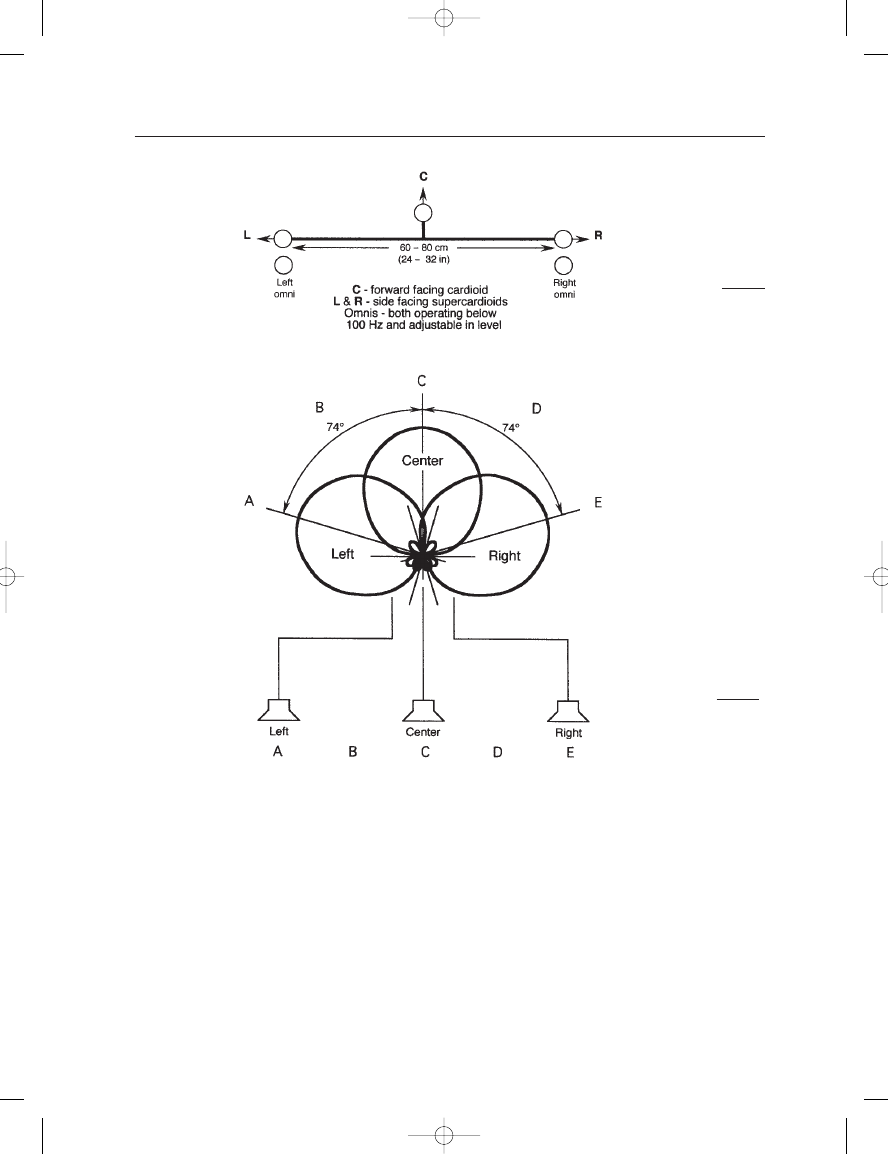
at left and right are primarily for restoring the normal LF rolloff caused
by the supercardioid microphones.
A second-order cardioid coincident frontal array can be conceived as
shown in Figure 15–16 (Cohen and Eargle, 1995). While a number of
engineering obstacles still remain in realizing this configuration, the
array has pickup characteristics that virtually eliminate phantom images
between left and right loudspeakers, while providing uniform pickup
over a 150
frontal angle. Adjacent crosstalk along the common left and
right microphone axis is about
15 dB, clearly indicating that signal
commonality between L and R will be minimum. The equation of the
second-order pattern is:
(0.5 0.5cos )(cos ).
THE MICROPHONE BOOK
256
FIGURE 15–15
Three-point frontal array
proposed by Schoeps.
FIGURE 15–16
Details of a coincident
array of three second-order
cardioids.
Earg_15.qxd 14/9/04 2:56 PM Page 256
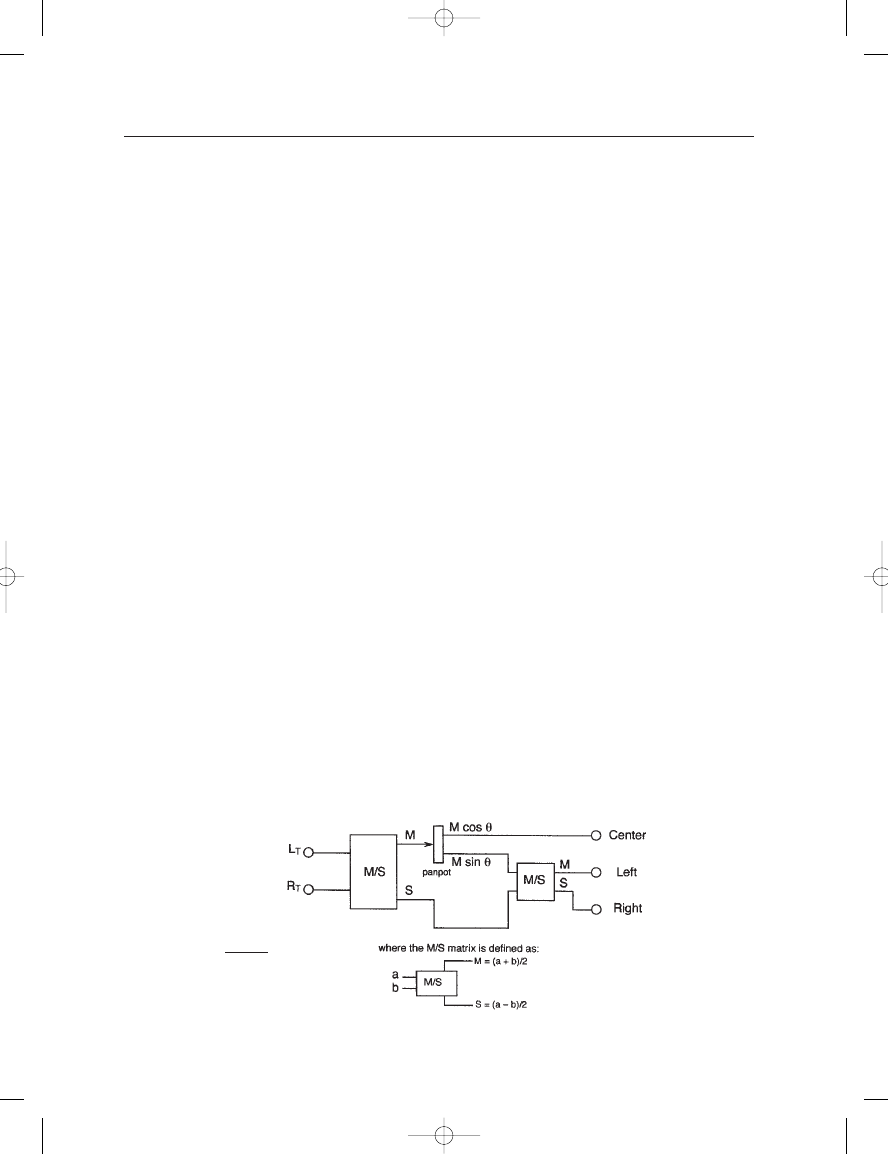
The foregoing discussion has dealt with minimizing crosstalk, or
leakage, from the center channel into the front flanking channels, and the
microphone arrays we have shown will accomplish this. However, in
many pop mixes there is a preference for a strong frontal presentation of
a soloist, and many remix engineers and producers will purposely feed
some of the center channel into the left and right flanking channels to
accomplish this. The level of this added feed is about 3 dB lower than
that present in the center channel, and it produces something resembling
a “wall of sound” from the front. This a judgement call on the part of
the engineer and producer and is based on musical requirements rather
than technical requirements. Proceed with caution when doing this.
CREATING A CENTER CHANNEL FROM A LEFT-RIGHT
STEREO PAIR OF CHANNELS
The reader will have noticed that several of the microphone arrays dis-
cussed so far have no specific center channel microphone. In these cases,
as well as in remixing older stereo program material for surround sound,
it is often necessary to synthesize a center channel from a stereo pair.
Gerzon (1992) describes a matrix network that accomplishes this,
albeit with some loss of overall left-right separation in the frontal three-
loudspeaker array. The circuit, shown in Figure 15–17, may look fairly
complex, but it can easily be set up on any console that has switchable
polarity inversion in its line input sections as well as a flexible patch bay.
It can also be set up on the virtual console pages of many computer based
editing programs.
Here is an example of its application: Assume we have a stereo
recording with three main signal components: left, phantom center and
right. The stereo channels may then be represented as:
L
T
L 0.7C
R
T
R 0.7C
where C represents the panned center signal, such as a vocalist, and L
and R represent discrete left and right program elements. L
T
and R
T
com-
prise the left-total and right-total stereo program. The matrix separation
15: Surround Sound Microphone Technology
257
FIGURE 15–17
Gerzon 2-3 matrix for
deriving a center channel
from a stereo program pair.
Earg_15.qxd 14/9/04 2:56 PM Page 257